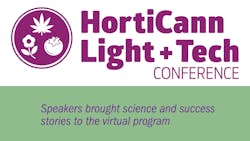Virtual HortiCann delivers on plant physiology to LED performance (MAGAZINE)
Our 2020 HortiCann Light+ Tech Conference took place Oct. 20‒21 — virtually, of course, in this pandemic year. We made tremendous progress this year in expanding the scope beyond horticultural lighting; in fact, one of the talks covered here is a truly broad AgTech presentation with emphasis on artificial intelligence (AI) and data-driven growing. Still, we had great coverage on plant physiology and the advances in LEDs and solid-state lighting (SSL) development for horticulture. Horticulture is truly a burgeoning application. You have a brief window remaining to catch the conference archive.
Keynote speaker Bruce Bugbee, the director of the Crop Physiology Laboratory at Utah State University, kicked off the two days of HortiCann presentations. He began with the basics illustrating what he calls the nine cardinal parameters of plant growth (Fig. 1). Above ground, you have light, temperature, humidity, wind, and CO2. Below ground, you have root-zone temperature, water, nutrients, and oxygen. “This is a simple concept, but with profound consequences,” said Bugbee.
Bugbee said light is at the center of the plant growth process. If you change the light input, he observed, “The optimum level of all these other parameters changes.” And light can vary over an enormous span — which Bugbee referred to as a ten-fold range. “If we turn up the light, the flux of water through the plant increases,” he noted.
Next, Bugbee dug deeper into the light parameters and discussed quality and quantity. With respect to horticultural lighting, quality comes down to spectra and the effect that particular spectral energy has on plants.
Specifically, Bugbee addressed ultraviolet (UV), blue, green, red, and far-red photons and the physiological effect of each. He said UV spectra cause a plant to go into survival mode, essentially producing its own sunscreen, explaining, “They start synthesizing UV-blocking compounds to protect themselves.” Some of those compounds are secondary metabolites that have value to people. One such example is anthocyanins that can deliver reds or purples in a cultivar such as lettuce, and those comprise beneficial antioxidant compounds.
“There is interest in using UV to increase cannabinoid synthesis in cannabis,” said Bugbee. And his lab is studying that possibility. He also said while some researchers and growers have stated that such increases have been proven, that actual case is not so clear and there is more work needed to learn the effectiveness of UV.
The primary effect that blue photons have on plants is to inhibit cell expansion, according to Bugbee. He said plants perceive the blue energy as bright sunlight and “hunker down.” The impact on leaves is that they remain smaller and that’s potentially a negative, depending on the crop. But blue energy also reduces stem elongation and that’s a positive effect for many cultivars.
Green is good
Bugbee turned to green photons and said much of the predominant thinking that green is ineffective for photosynthesis is wrong. He said green energy is actually very good for photosynthesis, but the constraint is the limits on green LED power output and efficiency — the phenomena often collectively called the "green gap" in the LED and SSL sectors. Bugbee said that today we get mostly green energy from phosphor-converted white LEDs. The green photons are also very valuable in facilitating human vision. He said growers can’t identify subtle nutrient disorders or insect problems without green photons. He further noted that even high-pressure sodium (HPS) lighting will not allow people to see subtle disorders on plants.
Moving on to red photons, Bugbee said they are by far the most efficient at driving photosynthesis and also teased that red LEDs offer the best efficacy. Of course, he was not talking about efficacy for human vision characterized by lumens per watt (lm/W) but rather photon efficacy for plant growth characterized by the PPF (photosynthetic photon flux) relative to input power expressed in micro mols per joule (µmol/J). See some of our prior horticultural coverage for more information on horticultural metrics.
The final band Bugbee discussed was far red. Far-red spectra impact stem elongation and leaf size much like blue energy. But Bugbee also said far-red and green photons share an underappreciated trait: Both penetrate canopy and leaves more efficiently than the other photons discussed. So green and far red have value in reaching the lower leaves and stems of a plant.
Perfect LEDs for plants
The discussion of the different spectra was valuable in its own right, but it was also used by Bugbee to open the door for a discussion about the ideal LED mix for plants and the limits imposed by device physics today. Horticultural lighting manufacturers must trade off the cost of the various monochromatic or phosphor-converted LEDs, the relative efficiency of each, and the needs of plants. Looking forward at LED technology developments, he asked, “How good could these get over the next few years?”
Bugbee set out to compare monochromatic blue, red, and far-red LEDs alongside a phosphor-converted white LED and show the results of his lab’s research published earlier in 2020 (see Table 1). Blue LEDs offer the best wall-plug efficiency as 88% of the electrical power input in the devices is emitted in radiometric power or photons — a watt-per-watt metric. The story is different in photon or PPF efficacy where far-red LEDs top the list followed by red. But far-red LEDs cost ten times what white LEDs cost today with volume manufacturing of white LEDs for general lighting having driven price erosion. Bugbee said it’s not cost effective today to “load a fixture up” with red and far-red LEDs.
“This is going to change because of economies of scale,” said Bugbee. With more red LEDs being used, prices will drop and then even more red LEDs can be integrated into horticultural fixtures.
Growth versus development
Having laid a foundation for LEDs and SSL spectra, Bugbee went on to present more research on plant growth and development. He explained that within his lab, growth refers to the photosynthesis process and ultimately the dry weight of the plant, while development refers to the shape. Light intensity and quality affect growth and development differently, according to Bugbee.
The research discussed was based on the sativa strain of cannabis, and as is standard practice the methodology looks at the impact of light on photosynthesis for a single leaf of a plant. A graph showed that a cannabis leaf will saturate at about 50% of full sunlight, as it is considered a very high light crop. Lettuce, for example, would saturate at around 20% of full sunlight.
But there is a disconnect between a single leaf characterization and tests in a chamber with a large canopy of cannabis plants. The canopy photosynthesis continues to benefit from more light. He said, “Wow. Cannabis is still responding to sunlight all of the way up to full sunlight,” and added that it would take a lot of LEDs to deliver the equivalent of full sunlight.
Photon conversion efficiency
Bugbee also touched on another new metric called photon conversion efficiency. It relies on some of the math he had already covered but ultimately delivers a grams per mol (g/mol) measure of crop yield versus radiant energy. Some examples showed increased red and far red increases g/mol and Bugbee said, “We should be putting far-red LEDs in all of our fixtures.”
Osram Opto Semiconductors presented immediately after Bugbee in the program with a talk titled “Red Reigns Supreme,” delivered by Renil Singh. As the title implies, it reinforced many of Bugbee’s points and made his projection of more affordable red spectral energy prove omniscient. Osram has a new concept of a HortiWhite broad-spectrum LED that will combine with a Hyper Red LED to deliver more efficient and affordable red-enhanced yet broad spectrum.
Autonomous growing
Now let’s transition to some of the other compelling HortiCann presentations, starting with one focused on autonomous growing of tomatoes present by Evripidis Papadopoulos, a researcher and data analyst at LetsGrow based in the Netherlands. He was on the team of horticultural and technical professionals that won the Wageningen University & Research (WUR) Autonomous Greenhouse Challenge. The multi-stage contest started with around 25 teams that were winnowed to five finalists, which competed for six months in growing tomatoes in a Netherlands-based greenhouse without team members being physically present at the greenhouse.
The winning team was called Automatoes and included members spread around the globe. Papadopoulos said team members had varied specialties including data analysis, AI, machine learning, plant physiology, and more. Each team got an identical 98m2 chamber and a sixth chamber was manned by a traditional growing team from the university.
The five competitors got two days to install sensors, IT, and communications equipment, and then would not re-enter the greenhouse for the six-month duration of the contest. WUR personnel handled required manual tasks such as pruning. But the Automatoes team remotely and autonomously controlled all aspects of the growing chamber ranging from lighting to irrigation to environmental conditions.
The greenhouses were provided with some basic sensors installed, but the teams could add more complex sensors, cameras, and more. For example, Automatoes installed sensing to monitor how much light penetrated the canopy of the plants, reaching lower leaves and vine segments. That data was used to guide leaf pruning strategy relayed to the WUR workers.
Automatoes had developed a strategic dashboard to provide what Papadopoulos called a helicopter view of the situation in the greenhouse. For example, the dashboard included a graph that represents total radiation over time including from the sun, and hybrid (LED plus high-pressure sodium — HPS) lighting systems. The Automatoes team had established an algorithm to control temperature, called temperature optimization, based on the total amount of radiation and was able to monitor how well the automated system delivered optimum temperature at intervals as short as five minutes.
Algorithms for everything
Likewise, the team developed a ventilation optimization algorithm. The goal was to keep the vents closed as much as possible to conserve energy, maintain CO2 levels, and maintain higher humidity. Papadopoulos said that if you have to open the vents, you could rapidly drop relatively humidity to 60% and derail the photosynthesis process.
There were further algorithms used to control lighting. For example, the algorithms would coerce the desired daily light integral (DLI) and photoperiod. An irrigation algorithm was driven by AI and tuned for maximum yield. Indeed, the entire system was architected in a way to simplify the tasks of a grower while improving yield.
Overall, the techniques used by team Automatoes fall into the category of Data Driven Growing. By capturing data from efficient growing operations and applying the same algorithms in another farm, you can ensure success in yield for the second farm, and third, and fourth, etc. Papadopoulos worked on a project to prove out the concept that the algorithms developed for the Netherlands would apply elsewhere and successfully tested the concept in a Mexico greenhouse. Obviously, a different cultivar would require different algorithms.
Potential for LED improvement in horticulture
Morgan Pattison of consultancy Solid State Lighting Services presented in the same session with Papadopoulos and focused on the physics limitations on LED efficiency and how that translates to horticultural SSL products. He has done research wok for the US Department of Energy (DOE) in many areas of SSL and has worked with keynoter Bugbee on some projects.
He started by reviewing some DOE research on the potential energy savings that SSL can bring to horticultural lighting. The work focused on three applications — vertical farming, supplemental greenhouse, and high-intensity sole source, which implies indoor cannabis growing. Vertical farming is enabled by LEDs and almost solely served by LEDs, so there is no additional savings opportunity in that application.
But in greenhouse and cannabis, a complete SSL transition would save significant energy totaling around 34% (Table 2). The actual hard numbers are more impressive. In greenhouses, a complete LED conversion would save 11 tBTU/year (11 trillion BTUs). And because sole-source lighting for cannabis operates for longer hours, the savings could be 79 tBTU/year. And Pattison noted that LED further offers a potential of productivity or yield improvement.
Pattison took a quick look at the PPF efficacy of the primary types of lighting used in horticulture. The best double-ended HPS lamps deliver around 2.1 µmol/J, and there is additional ballast loss so the number is not quite that good in practice. Today the best SSL fixtures can deliver around 3.2 µmol/J, although Pattison said those are not the best fixtures for maximizing yield. Efficacy for the white-plus-red luminaires that Bugbee championed max out now at around 2.5 µmol/J, according to Pattison. He suggested SSL could ultimately reach 4 µmol/J.
Cannabis and light choices
In the same session with Pattison, we heard from Matt McGregor, strategic account advisor for cannabis operations at the Sacramento Municipal Utility District (SMUD). For more than five years, McGregor has worked directly with legal cannabis growers with an eye toward energy efficiency and minimizing the impact of the growing operations on the grid.
The heart of McGregor’s presentation was a comparison of HPS and LED technologies with double-ended HPS being the incumbent lighting technology used by cannabis growers. He said some growers who experimented with LEDs early on realized unacceptable results but noted incredible improvements in SSL products.
McGregor said he currently is engaged with 156 customers in the cannabis space, 58 of which are operational and 21 of which are using SSL for all or part of their operations. And 22 that are proposed and in the planning stage will use LED lighting.
Growers can compare HPS in several ways, explained McGregor. The most basic approach is to compare a one-for-one HPS to LED installation in identically-sized facilities. The latest 630W LED fixtures match 1000W HPS fixtures and deliver essentially the same yield. So there is a pure energy savings play.
LED facility yield
Of course, McGregor works for a utility and such a business thinks of things from an electricity perspective. You can make a comparison based on the capacity of a standard electrical panel. A 1000W panel will power 234 HPS fixtures or 345 LED fixtures, and the SSL option would still use 4.1% less energy with the additional fixtures. Now, granted you would need additional canopy/real estate space to deploy the additional fixtures, but based just on fixture count the HPS scenario yields 468 lb of crop while the LED scenario yields 690 lb — a 32% production efficiency advantage.
Now consider a volumetric approach. The heat from HPS fixtures will essentially mandate single-layer grow facilities. Even with cannabis that grows somewhat tall, some grow facilities are adding a second layer of lighting and canopy. So a 20,000-ft2 HPS facility could support 10,000-ft2 of canopy while a two-layer LED installation could double that canopy. You can see the details in the nearby Table 3. Without consideration of electrical panel factors, you can double yield with a relatively modest increase in electrical energy. And realize that all three of these comparisons are per growing cycle. Modern facilities average 5.5 cycles per year.
Moreover, none of McGregor’s comparisons addressed the potential for SSL to enhance yield through spectra. Bugbee, as we wrote earlier, said that something like UV is not a sure thing to improve crops. But many think it works. Valoya presented results of several experiments it has run internally that show increased cannabinoid production coerced by spectra. We continue to expect the cannabis industry to undergo a massive retrofit evolution from HPS to SSL.
Visit our website for more on HortiCann
Access to the HortiCann Light + Tech conference virtual platform is expected to close soon. If you missed the event, this post-conference report brings you a round-up on a number of exciting research- and market-data-backed presentations. Still, there is more on our website if you haven’t seen our online exclusive Day 1 wrap report, which summarizes some of the other key points of the day. We also featured a blog highlighting the excellent Closing Plenary, a panel session moderated by Cornell GLASE (Greenhouse Lighting and Systems Engineering) Consortium director Erico Mattos, diving into perspectives on horticultural SSL, AgTech, and case studies direct from growers.
Stay up to date on HortiCann announcements, research & development, commentary, and other horticultural and AgTech news and insights by subscribing to our monthly HortiCann Light + Tech newsletter.
For up-to-the-minute LED and SSL updates, why not follow us on Twitter? You’ll find curated content and commentary, as well as information on industry events, webcasts, and surveys on our LinkedIn Company Page and our Facebook page.

Maury Wright | Editor in Chief
Maury Wright is an electronics engineer turned technology journalist, who has focused specifically on the LED & Lighting industry for the past decade. Wright first wrote for LEDs Magazine as a contractor in 2010, and took over as Editor-in-Chief in 2012. He has broad experience in technology areas ranging from microprocessors to digital media to wireless networks that he gained over 30 years in the trade press. Wright has experience running global editorial operations, such as during his tenure as worldwide editorial director of EDN Magazine, and has been instrumental in launching publication websites going back to the earliest days of the Internet. Wright has won numerous industry awards, including multiple ASBPE national awards for B2B journalism excellence, and has received finalist recognition for LEDs Magazine in the FOLIO Eddie Awards. He received a BS in electrical engineering from Auburn University.









